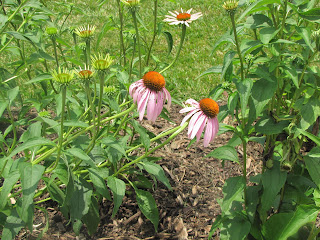I have always thought that this passage from the book of Ecclesiastes, written by the very wise Solomon, is one of the most beautiful segments of the Bible.
1. To everything there is a season,
A time for every purpose under heaven:
2 A time to be born,
And a time to die;
A time to plant,
And a time to pluck what is planted;
3 A time to kill,
And a time to heal;
A time to break down,
And a time to build up;
4 A time to weep,
And a time to laugh;
A time to mourn,
And a time to dance;
5 A time to cast away stones,
And a time to gather stones;
A time to embrace,
And a time to refrain from embracing;
6 A time to gain,
And a time to lose;
A time to keep,
And a time to throw away;
7 A time to tear,
And a time to sew;
A time to keep silence,
And a time to speak;
8 A time to love,
And a time to hate;
A time of war,
And a time of peace.
Ecclesiastes 3:1-8
The preacher read this at my Grandpa Gean's funeral. I was fourteen, and not very familiar with scripture. Even on that sad day, this passage was so beautiful that my spirit grabbed it and has never let go.
This passage is more familiar than some parts of the Bible, in part because Pete Seeger put it to music in 1959. He recorded it in 1962, but it wasn't until it was covered by the Byrds in 1965 that it became a national hit. Most people could sing along with it, some not realizing that they were quoting scripture almost word for word as they sang.
In the coming days, I hope to use this passage of scripture to try and understand the times and seasons. Please join me. I always welcome your ideas and thoughts on whatever I write here.
2 A time to be born,
And a time to die;
A time to plant,
And a time to pluck what is planted;
3 A time to kill,
And a time to heal;
A time to break down,
And a time to build up;
4 A time to weep,
And a time to laugh;
A time to mourn,
And a time to dance;
5 A time to cast away stones,
And a time to gather stones;
A time to embrace,
And a time to refrain from embracing;
6 A time to gain,
And a time to lose;
A time to keep,
And a time to throw away;
7 A time to tear,
And a time to sew;
A time to keep silence,
And a time to speak;
8 A time to love,
And a time to hate;
A time of war,
And a time of peace.
Ecclesiastes 3:1-8
And a time to die;
A time to plant,
And a time to pluck what is planted;
3 A time to kill,
And a time to heal;
A time to break down,
And a time to build up;
4 A time to weep,
And a time to laugh;
A time to mourn,
And a time to dance;
5 A time to cast away stones,
And a time to gather stones;
A time to embrace,
And a time to refrain from embracing;
6 A time to gain,
And a time to lose;
A time to keep,
And a time to throw away;
7 A time to tear,
And a time to sew;
A time to keep silence,
And a time to speak;
8 A time to love,
And a time to hate;
A time of war,
And a time of peace.
Ecclesiastes 3:1-8
The preacher read this at my Grandpa Gean's funeral. I was fourteen, and not very familiar with scripture. Even on that sad day, this passage was so beautiful that my spirit grabbed it and has never let go.
This passage is more familiar than some parts of the Bible, in part because Pete Seeger put it to music in 1959. He recorded it in 1962, but it wasn't until it was covered by the Byrds in 1965 that it became a national hit. Most people could sing along with it, some not realizing that they were quoting scripture almost word for word as they sang.
In the coming days, I hope to use this passage of scripture to try and understand the times and seasons. Please join me. I always welcome your ideas and thoughts on whatever I write here.



Yes, he was a wise man, writing so many things that fit today perfectly. I love watching the moon as it comes to be full and then slowly back to the new moon, and the sun, as it creeps into the south windows in the winter, then backs up until in June there's only a sliver on the window sill. Aren't we blessed!
ReplyDeleteYes, we are a blessed people! Thanks for reading and commenting!
Delete